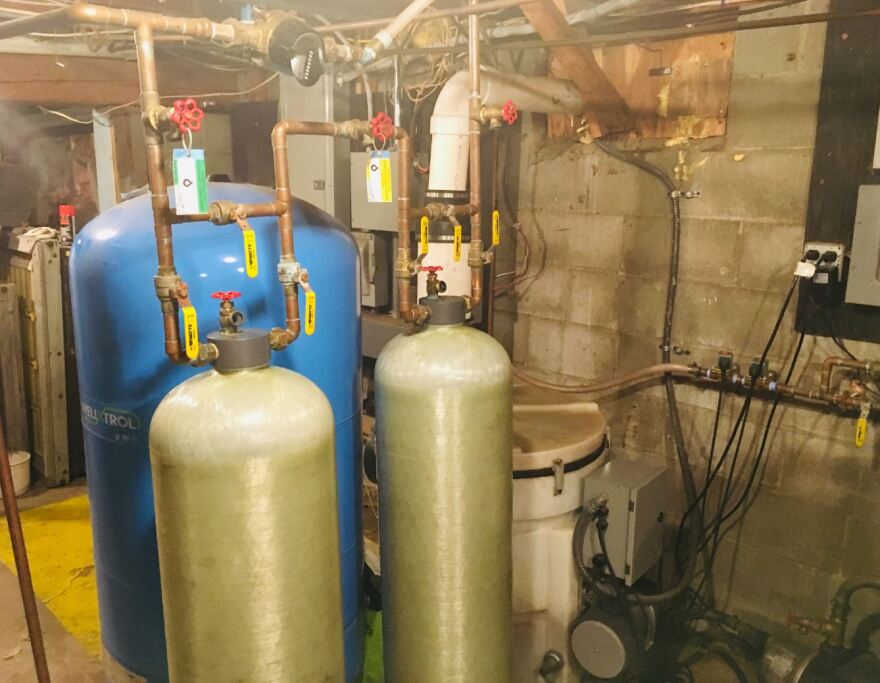This summer, towns in southern New Hampshire are breaking ground on what will become the state’s largest regional water system. It is being built in part with money from massive settlements between New Hampshire and gas companies, including ExxonMobil, that used to produce MtBE, a chemical that polluted local drinking water.

For some residents in Plaistow, the new system will provide a permanent solution to MtBE pollution that has plagued them for over thirty years.
For Paul Sickel, the problems started in 1985. One day, the basement of his family-owned store, Westville True Value Hardware, filled up with fumes.
“They called the fire department: ‘We’ve got a leak, there’s something going on,’” he remembers.
Across the street, at the time, was a gas station, infamous for its high turnover rate and struggle to turn a profit.
It turned out its gas tank had been leaking thousands of gallons of gasoline into the ground, permeating nearby soil and wells with the gasoline additive MtBE. It’s carcinogenic; and once it’s in the groundwater, it’s there to stay.
“For the longest time I had the distinction of having the dirtiest well in the state,” Sickel jokes.
After the pollution was discovered, the New Hampshire Department of Environmental Services started testing nearby wells and found dozens with MtBE - so the state began installing point-of-entry (POE) filtration systems.
Sickel walks me over to his POE system, a labyrinth of tubes and cylinders with carbon filters that extract gasoline and other chemicals. The process requires constant upkeep by the state; since 2002 alone, New Hampshire has spent over $5 million installing and maintaining POE systems like Sickle’s to address MtBE contamination.
'For the longest time I had the distinction of having the dirtiest well in the state,' Sickle jokes.
“When they change the carbon filter it is the smelliest, nastiest - it’s considered hazardous material. Because that’s where all the petrochemicals are captured,” he says.
It’s taken a long time for Sickel to finally feel safe drinking this filtered water - MtBE contamination has been a major headache for him and dozens others in Plaistow.

And that’s not all. Just last year, the town discovered toxic PFAS chemicals in well water not far from Sickle’s store. There are also high levels of the naturally occurring chemicals of arsenic, radon and iron, common in wells all over the state.
The problem is, there is nowhere else for people to get water in Plaistow. The town has no rivers, no big ponds, and no municipal water system to draw from if a private well goes bad.
So Plaistow and state officials started looking elsewhere. They decided on Lake Massabesic, east of Manchester, which spans 2,500 acres and can hold up to 15 billion gallons of water. Manchester Water Works (MWW) treats and sells the water to Manchester and surrounding towns.
David Miller, Deputy Director of MWW’s Water Treatment & Supply, brought me on a tour of the shoreline. There are barely any houses; much of it is fenced off to protect the watershed.
Taking in the glittering expanse, Miller points out a loon.
“You go out on Lake Massabesic it’s like going back in time - that’s the simplest way I can say it,” he says. “It’s really pretty out there.”

A few years ago, MWW started meeting with a group of state and town officials, engineers, and members of private water utility companies to figure out how to get this water to Plaistow and other towns with MtBE contamination and limited water supply.
With the Southern New Hampshire Regional Water Interconnection Project, MWW will sell up to 3 million gallons per day to its southern neighbors.
As for the pipes to get it there, New Hampshire is using $27 million from the over $300 million in funds from MtBE-related lawsuits to build the main pipe, running 14 miles from Derry to Plaistow through Salem, Windham, and Atkinson.

In addition to providing water to Plaistow and Windham residents with contaminated wells, the project will increase water flow to Salem, where MtBE has polluted some municipal water supplies, increasing pressure on Canobie Lake.
Even as efficient appliances decrease per-capita water demand, Salem expects its overall demand to increase with the expansion of the Tuscan Village development. Many see the regional water project as a solution to water shortages anticipated in the future.
The private water utility Hampstead Area Water Company (HAWC) will also get more water, which officials hope will alleviate demand on the local bedrock aquifers in Hampstead and Atkinson.
All the involved towns and utility companies have agreed to do their part to build and maintain the connecting pipes, meters, and water storage units.
Erin Holmes, an engineer with the MtBE Remediation Bureau at the New Hampshire Department of Environmental Services, says the project is one of the most significant undertakings in the state’s recent water history.
“This is the first time we’ve put this many people in the room with the goal of bringing the water down,” she says.

Water is usually a local matters, personal, even - nearly half of state residents are on their own well, and regions rarely collaborate on water issues.
“You go anywhere in New Hampshire, you’re going to find towns that won’t talk to your neighbors,” Homles says. “They don’t work together - I think part of this [project] is showing that in this era, with contamination, with issues that everybody is facing, you can’t put your walls up with your neighbor - you have to work together.”
Republican Senator Morse, of Salem, has helped spearhead the project with Holmes. He says until now, the prevalence of contamination and limited water supply has stymied development.
“A lot of people want to move in here and a lot of people want the opportunity to build here,” he says. “By bringing this source into the communities, it will help with the local debates because they’ll know they have enough water.”
Enough water could mean more development in southern New Hampshire. Some conservationists worry this could lead to new environmental problems.
And that’s not the only unknown. When people with bad wells start to hook up to this system around 2020, they’ll have to pay for municipal water for the first time. They don’t know yet how much this will cost, but they do know the water will be cleaner than what’s in their wells today.
“It will be clean water,” Paul Sickel, of Plaistow, says. “And you can’t put a price on that.”








